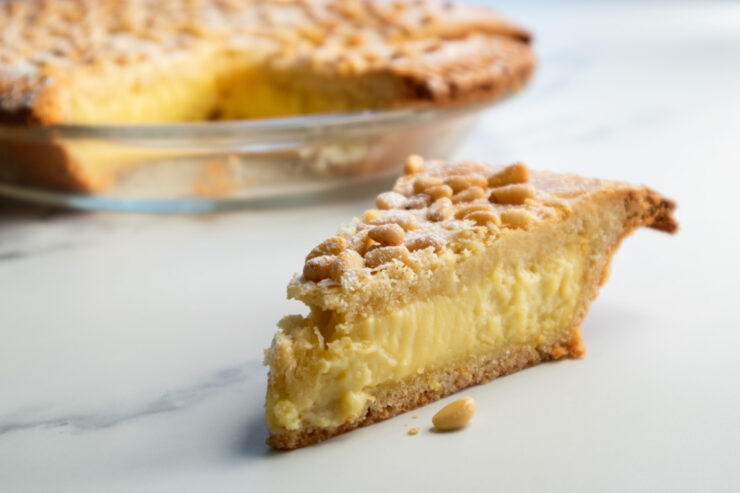
Torta della nonna, literally “grandmother’s cake,” is a rustic tart made from two simple Italian classics: pasta frolla and crema pasticcera. Lemony pastry cream is sandwiched between two crumbly layers of sweet shortcrust pastry and covered in toasted pine nuts and confectioners’ sugar.
Torta della Nonna History:
While the name torta della nonna may evoke an Italian grandmother lovingly throwing together a cake for Sunday’s family meal, it was not actually invented by an Italian grandmother at all.
While it’s contested in nearby Abruzzo, torta della nonna was most likely invented in a restaurant in Florence in the early 1900s by chef Guido Samorini.
According to the story, patrons at his restaurant were unimpressed by the lackluster selection of desserts and he was challenged to create something new. When he started serving torta della nonna, customers were struck by its rustic simplicity.

Tips for Baking Torta della Nonna:
- The method for making the pastry dough is a bit different from other recipes you might have seen. Rather than cutting cold butter into the flour, the room temperature ingredients are mixed like cookie dough. The butter and sugar are combined, followed by the egg, and then the flour is folded in just until the dough comes together.
- Try not to overwork the dough when mixing, as it can result in a tough tart shell that shrinks when baked.
- When rolling out the dough, make sure it is thoroughly chilled. As the dough warms up, it will begin to stick to the work surface.
- For the pastry cream, gradually pour the hot milk into the egg yolk mixture and whisk constantly. By adding the milk slowly, you temper the eggs and prevent them from curdling.
- After the pastry cream starts to bubble, continue to cook it for another minute. This ensures the starch is fully cooked and the pastry cream won’t break down.
- A trick to prevent the pine nuts from burning in the oven is to soak them in water for a few minutes before scattering them over the tart.
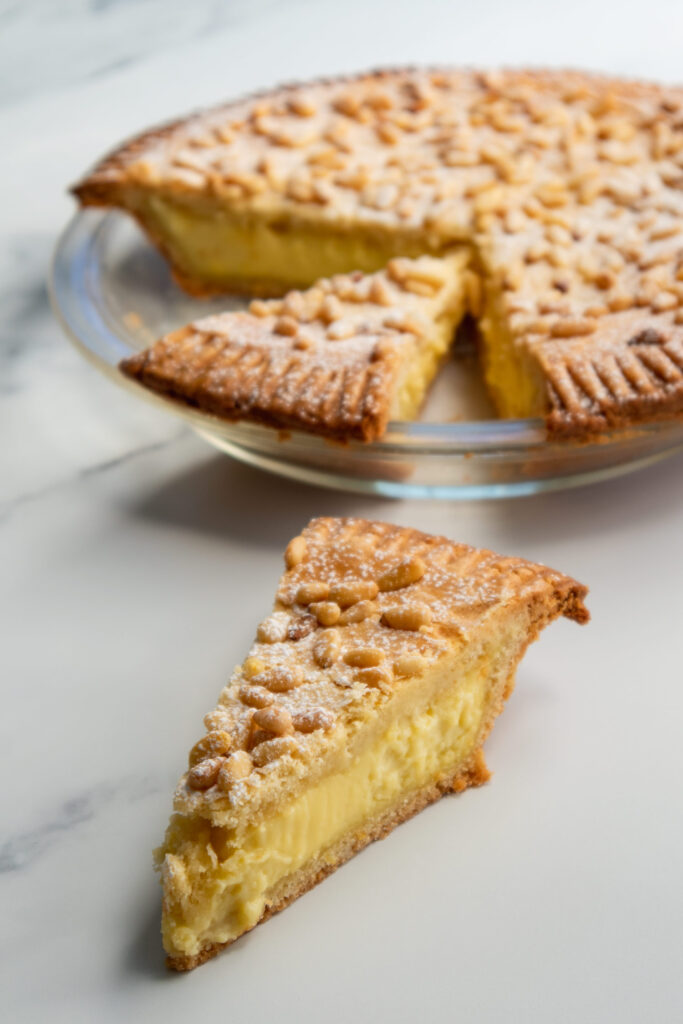
Ingredients:
Yields one 9-inch (23cm) tart.
300g plain flour
1 teaspoon baking powder
1/4 teaspoon salt
200g unsalted butter, softened to room temperature
115g confectioners’ sugar
Zest of 1 lemon
1 large egg, room temperature
Yolk from 1 large egg, room temperature
CREMA PASTICCERA
100g granulated sugar
30g cornstarch
1/4 teaspoon salt
Yolks from 5 large eggs
500ml whole milk
Zest of 1 lemon
30g unsalted butter, cubed
1 teaspoon vanilla extract
EGG WASH
1 large egg
1 teaspoon water
TOPPING
50g pine nuts
Confectioners’ sugar
2 1/2 cups all-purpose flour
1 teaspoon baking powder
1/4 teaspoon salt
14 tablespoons unsalted butter, softened to room temperature
1 cup confectioners’ sugar
Zest of 1 lemon
1 large egg, room temperature
Yolk from 1 large egg, room temperature
CREMA PASTICCERA
1/2 cup granulated sugar
3 tablespoons cornstarch
1/4 teaspoon salt
Yolks from 5 large eggs
2 cups whole milk
Zest of 1 lemon
2 tablespoons unsalted butter, cubed
1 teaspoon vanilla extract
EGG WASH
1 large egg
1 teaspoon water
TOPPING
1/3 cup pine nuts
Confectioners’ sugar
Prepare the Pasta Frolla
1. Whisk together the flour, baking powder, and salt:
Whisk together the flour, baking powder, and salt in a mixing bowl. Set aside.
2. Combine the butter and sugar:
In the bowl of a stand mixer with the paddle attachment, or in a large bowl with a rubber spatula, combine the butter, confectioners’ sugar, and zest and mix until smooth.
3. Add the egg and egg yolk:
Add the egg and the egg yolk and mix until combined.
4. Add the flour mixture:
Add the flour mixture and mix on low speed just until incorporated. The dough should just come together into a smooth ball. As soon as it does, stop mixing or the pastry will lose its delicate short texture.
5. Rest and chill:
Wrap the dough in plastic and leave it to rest in the refrigerator for at least 1 hour.
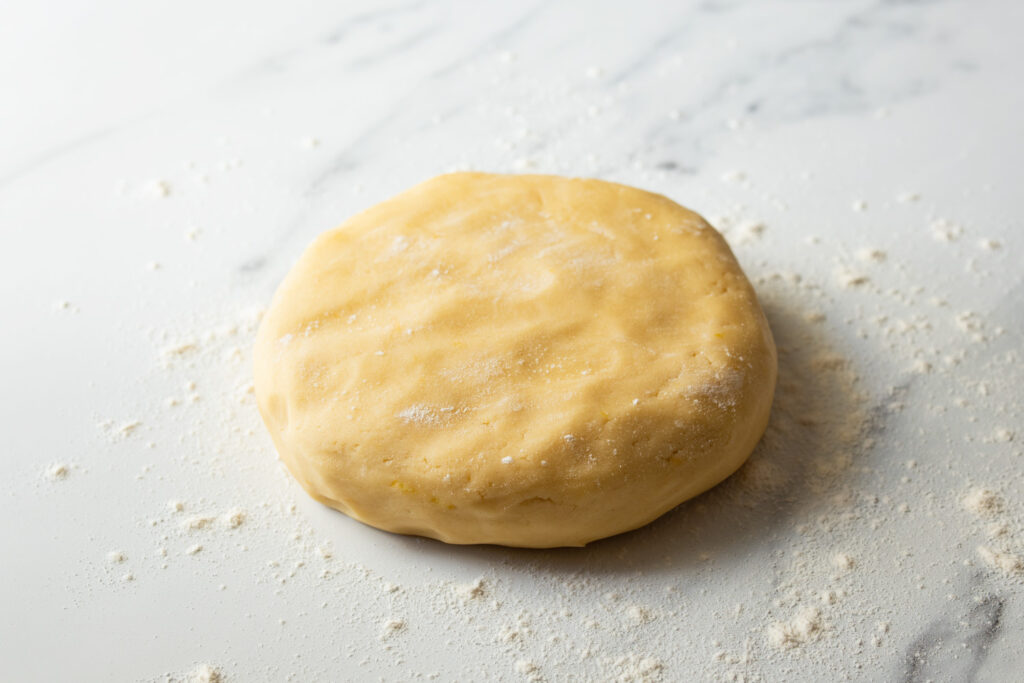
Prepare the Crema Pasticcera
1. Stir together sugar, cornstarch, salt:
Whisk together the sugar, cornstarch, and salt in a mixing bowl.
2. Whisk in the egg yolks:
Whisk in the egg yolks and mix until pale and smooth, about 1 minute.
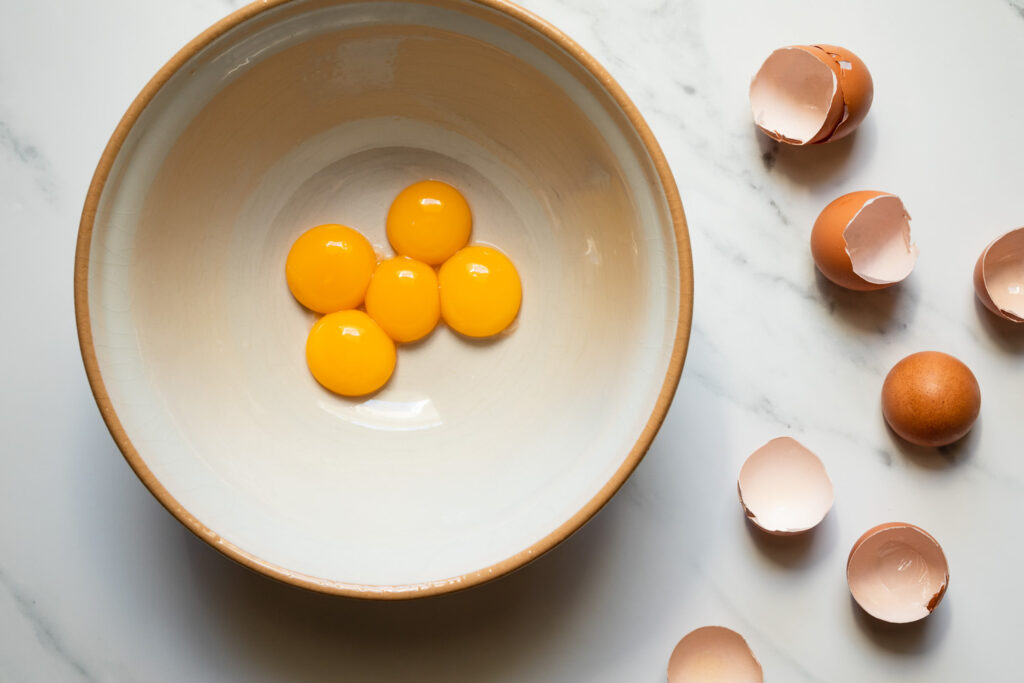
3. Bring milk to a simmer:
Combine the milk and the lemon zest in a medium saucepan and bring to a simmer over medium heat.
4. Add the milk to the yolk mixture:
When the milk comes to a simmer, remove it from the heat. Slowly pour the hot milk into the yolk mixture a splash at a time, whisking constantly.
5. Cook the pastry cream:
Transfer the mixture back into the saucepan and cook over medium heat until it begins to bubble. Then continue to cook for 1 more minute.
6. Whisk in the butter:
Remove the pastry cream from the heat. Whisk in the cubed butter until melted and completely incorporated. Stir in the vanilla extract.
7. Strain and chill:
Pour the pastry cream through a fine-mesh strainer into a bowl and cover with plastic wrap directly on the surface of the cream. Refrigerate until cool.
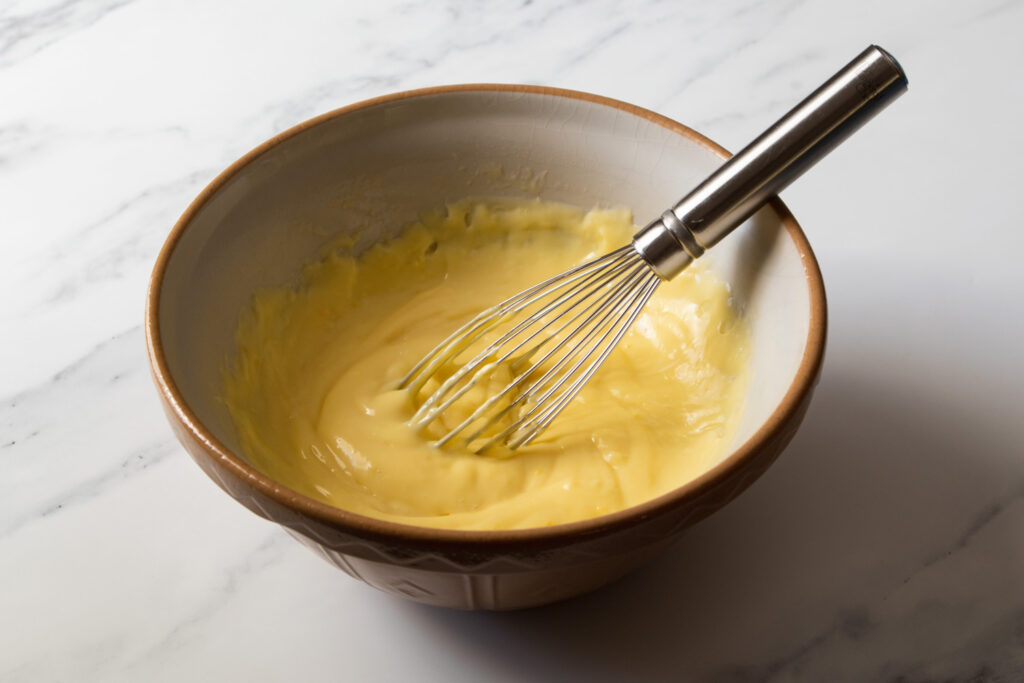
Assemble the Tart
1. Preheat the oven:
Preheat the oven to 175°C (350°F). Butter and flour a 9-inch (24cm) tart pan or pie dish.
2. Roll out the dough:
Take the pastry out of the refrigerator. Unwrap the dough, dust it with flour and place it on a lightly floured work surface.
Divide the dough into two pieces: 2/3 of the dough for one piece and the remaining 1/3 for the other.
Use a rolling pin to roll the larger piece of dough into a circle, making sure it is slightly larger than the tart pan so there is enough dough to go up the sides.
3. Line the tart pan:
Carefully transfer the dough into the pan. Gently press the dough into place without stretching the dough or the sides will shrink while it bakes. Trim any excess dough. Prick all over with a fork.
4. Fill the tart:
Fill the tart with the cooled pastry cream and level the top.
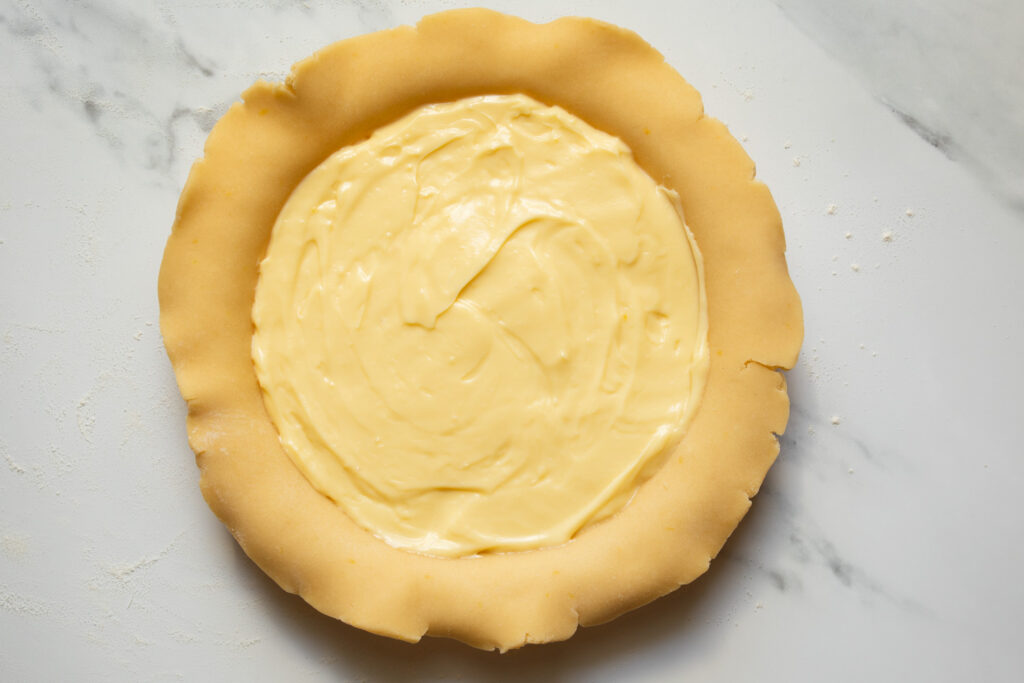
5. Top the tart:
Roll out the remaining piece of dough just large enough to cover the tart. Trim any excess dough from the edges. Seal the tart by pinching the edges together with your fingers or using the tines of a fork.
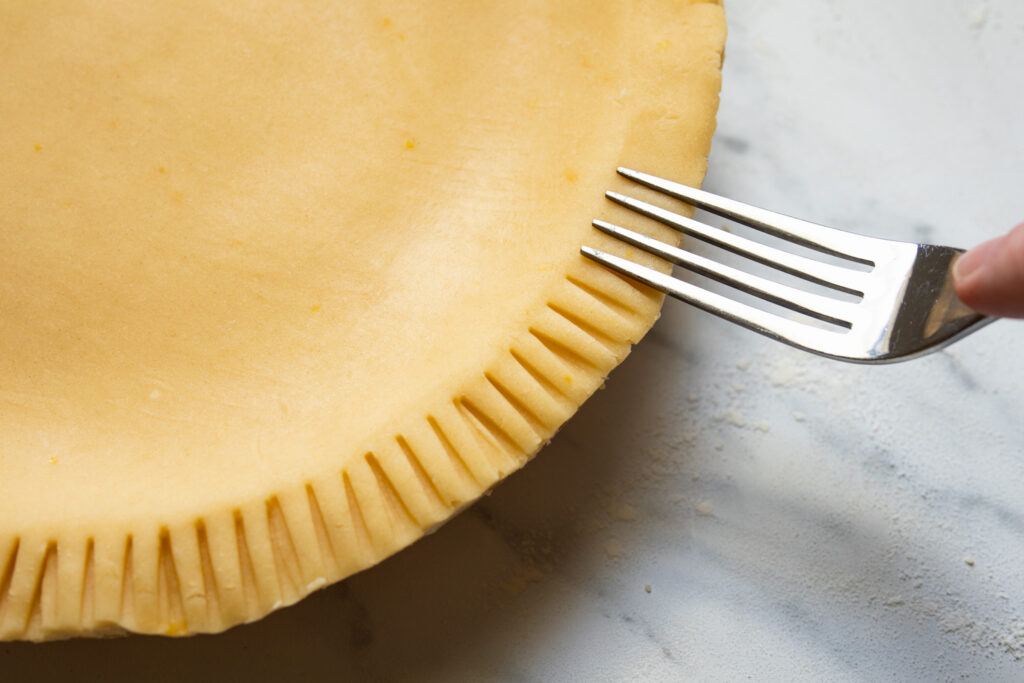
6. Sprinkle on the pine nuts:
Beat an egg with a teaspoon of water in a small bowl to make an egg wash. Brush the top of the cake lightly with the egg wash. Sprinkle the pine nuts over the top of the tart.
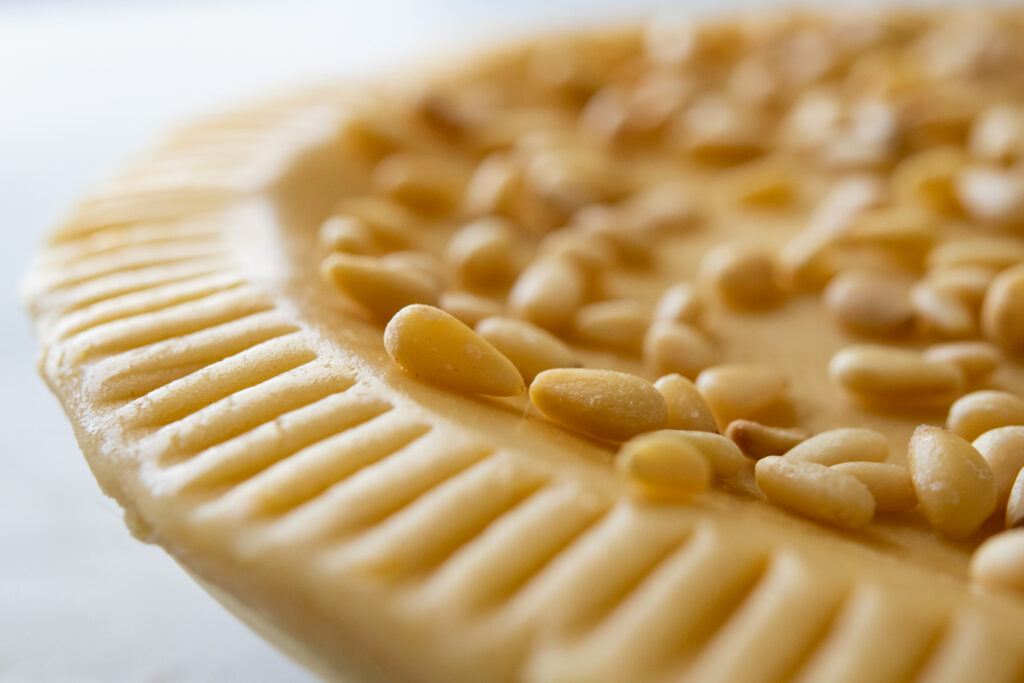
7. Bake:
Bake the tart in the preheated oven until golden brown, about 40 to 45 minutes.
8. Cool:
Allow the tart to cool completely before dusting with confectioners’ sugar and slicing.
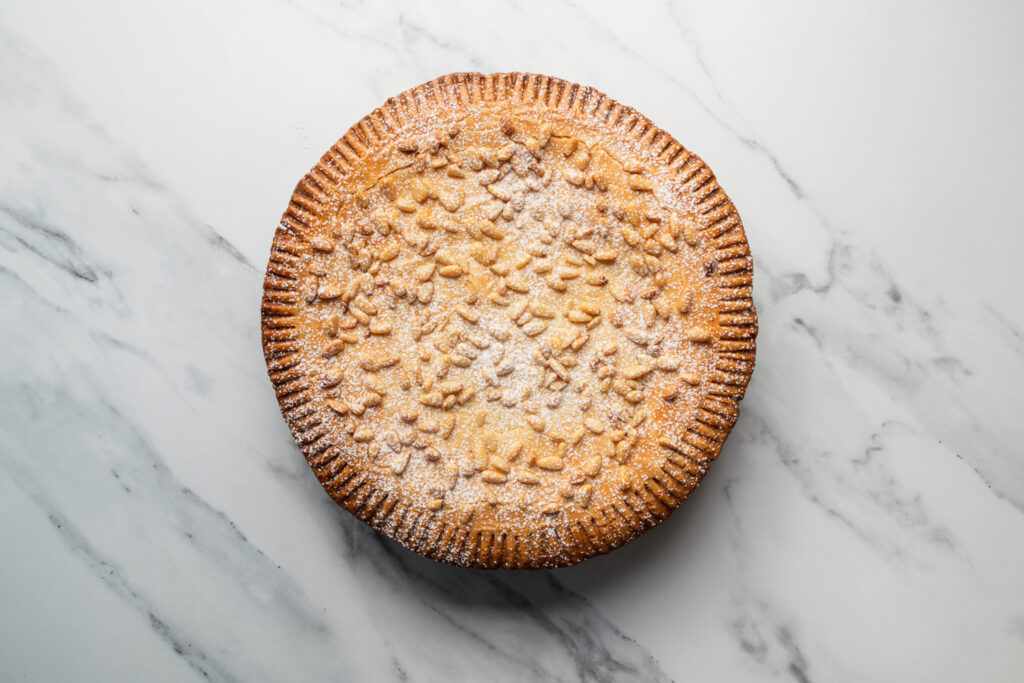
How long does torta della nonna keep?
Torta della nonna can be stored in the refrigerator for up to 4 days, but it softens after a day or two.
Can torta della nonna be frozen?
Torta della nonna cannot be frozen because of the pastry cream. When water freezes, it crystallizes, and the water crystals shred through the pastry cream and make it soupy when it thaws.
Can torta della nonna be prepped in advance?
The pasta frolla and pastry cream can be made ahead of time and stored separately in the refrigerator. Pasta frolla can be frozen for up to 1 month.

cheers for the recipe my guy #nonnaforlife
Thanks! Torta della nonna is such a good classic dessert
Decadent and just beautiful, thank you for the recipe and the step by step guidance
Thank you Joe, I’m glad you enjoyed it. Happy Baking!